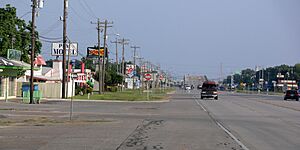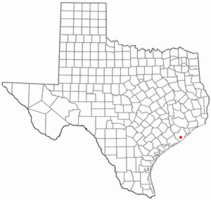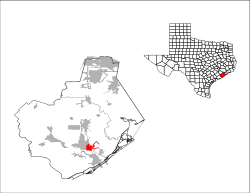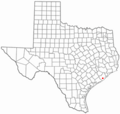Clute, Texas facts for kids
Quick facts for kids
City of Clute
|
|
|---|---|

SH 288 Business in Clute
|
|

Location in the state of Texas
|
|
 |
|
| Country | United States |
| State | Texas |
| County | Brazoria |
| Incorporated | May 1952 |
| Founded by | Soloman J. Clute |
| Government | |
| • Type | Council-Manager |
| Area | |
| • Total | 5.69 sq mi (14.73 km2) |
| • Land | 5.32 sq mi (13.78 km2) |
| • Water | 0.37 sq mi (0.95 km2) |
| Elevation | 10 ft (3 m) |
| Population
(2020)
|
|
| • Total | 10,604 |
| • Density | 2,197.78/sq mi (848.58/km2) |
| Time zone | UTC-6 (CST) |
| • Summer (DST) | UTC-5 (CDT) |
| ZIP code |
77531
|
| Area code(s) | 979 |
| FIPS code | 48-15652 |
| GNIS feature ID | 2409490 |
| Website | http://ci.clute.tx.us/ |
Clute is a city in Texas, located in Brazoria County. It's part of the larger Houston metropolitan area. In 2020, about 10,604 people lived here. Clute is famous for a cool discovery: a fossilized mammoth named Asiel!
Contents
History of Clute
The story of Clute started where two old plantations met. One was owned by Alexander Calvit, who got the land in 1824. He was one of Stephen F. Austin's first settlers in Texas. The other plantation belonged to Jared Groce, a very rich man.
After the American Civil War, a community began to grow here. It was founded by Joseph Pegan, Soloman J. Clute, and other relatives like George and John Clute. In 1881, the community was officially named Clute. This happened when Soloman J. Clute bought both of the old plantations.
George Clute was described as a "little Yankee from New York." The Clute family bought more land in the 1870s. Soloman Clute managed the community until around 1888 or 1889, when it was sold.
In 1933, Clute was very small, with only two businesses and ten people. But things changed in the early 1940s! The city started to grow a lot. This was because Dow Chemical and other big construction companies moved into the area.
A post office opened by 1943. A new grade school was built in the 1950s. By 1950, Clute had 700 people and 36 businesses. In 1954, the population grew to 3,200, and there were 45 businesses.
Clute became an official city in May 1952. It was first called Clute City. In 1955, the name changed back to Clute. The city also changed how its government worked.
Brazoswood High School opened in Clute in 1969. The first class graduated in 1971. The school's football team even won the state championship in 1974!
Mammoth Discovery
In November 2003, something amazing was found in a sand pit near Brazoswood High School. A backhoe operator discovered a pair of mammoth tusks! These tusks are believed to be from the first mammoth ever found on the Texas Gulf Coast.
Scientists think the mammoth is about 38,000 years old. They figured this out by looking at old logs found nearby. This mammoth was a Columbian mammoth. These mammoths were a bit bigger and had less hair than their famous cousins, the woolly mammoth.
Other fossils were also found, like parts of bison, horses, deer, and turtles. These finds help us understand what the Ice Age environment was like 35 feet underground.
Today, there's even a restaurant and museum named after the mammoth discovery. It helps honor this cool find!
Geography of Clute
Clute covers an area of about 5.6 square miles (14.7 square kilometers). Most of this area is land, about 5.3 square miles (13.78 square kilometers). The rest, about 0.3 square miles (0.95 square kilometers), is water.
Population and People
Clute has grown a lot over the years. Here's how the population has changed:
| Historical population | |||
|---|---|---|---|
| Census | Pop. | %± | |
| 1960 | 4,501 | — | |
| 1970 | 6,023 | 33.8% | |
| 1980 | 9,577 | 59.0% | |
| 1990 | 8,910 | −7.0% | |
| 2000 | 10,424 | 17.0% | |
| 2010 | 11,211 | 7.5% | |
| 2020 | 10,604 | −5.4% | |
| U.S. Decennial Census | |||
In 2020, there were 10,604 people living in Clute. There were 4,453 households and 2,854 families.
Here's a look at the different groups of people living in Clute in 2020:
| Race | Number | Percentage |
|---|---|---|
| White (NH) | 3,404 | 32.1% |
| Black or African American (NH) | 1,040 | 9.81% |
| Native American or Alaska Native (NH) | 45 | 0.42% |
| Asian (NH) | 94 | 0.89% |
| Pacific Islander (NH) | 3 | 0.03% |
| Some Other Race (NH) | 46 | 0.43% |
| Mixed/Multi-Racial (NH) | 280 | 2.64% |
| Hispanic or Latino | 5,692 | 53.68% |
| Total | 10,604 |
In 2000, there were 10,424 people in Clute. About 41% of households had children under 18. The average household had about 2.79 people. The average family had about 3.35 people.
The median age in the city was 28 years old. This means half the people were younger than 28, and half were older.
Education in Clute
Public schools in Clute are run by the Brazosport Independent School District. Here are the schools in Clute:
- Madge Griffith Elementary School
- T. W. Ogg Elementary School
- Clute Intermediate School
- Brazoswood High School
Clute is also served by Brazosport College. The Clute Library is part of the Brazoria County Library System.
Culture and Events
Clute hosts a fun event called "The Great Texas Mosquito Festival" every July. This festival has been happening every year since 1981. It's a popular three-day event that brings in about 18,000 visitors!
Notable Person
- Ron Paul – A former U.S. Representative, Ron Paul lives in Clute. His son, Senator Rand Paul, also went to high school here.
Images for kids
-
Location in the state of Texas
See also
 In Spanish: Clute (Texas) para niños
In Spanish: Clute (Texas) para niños




